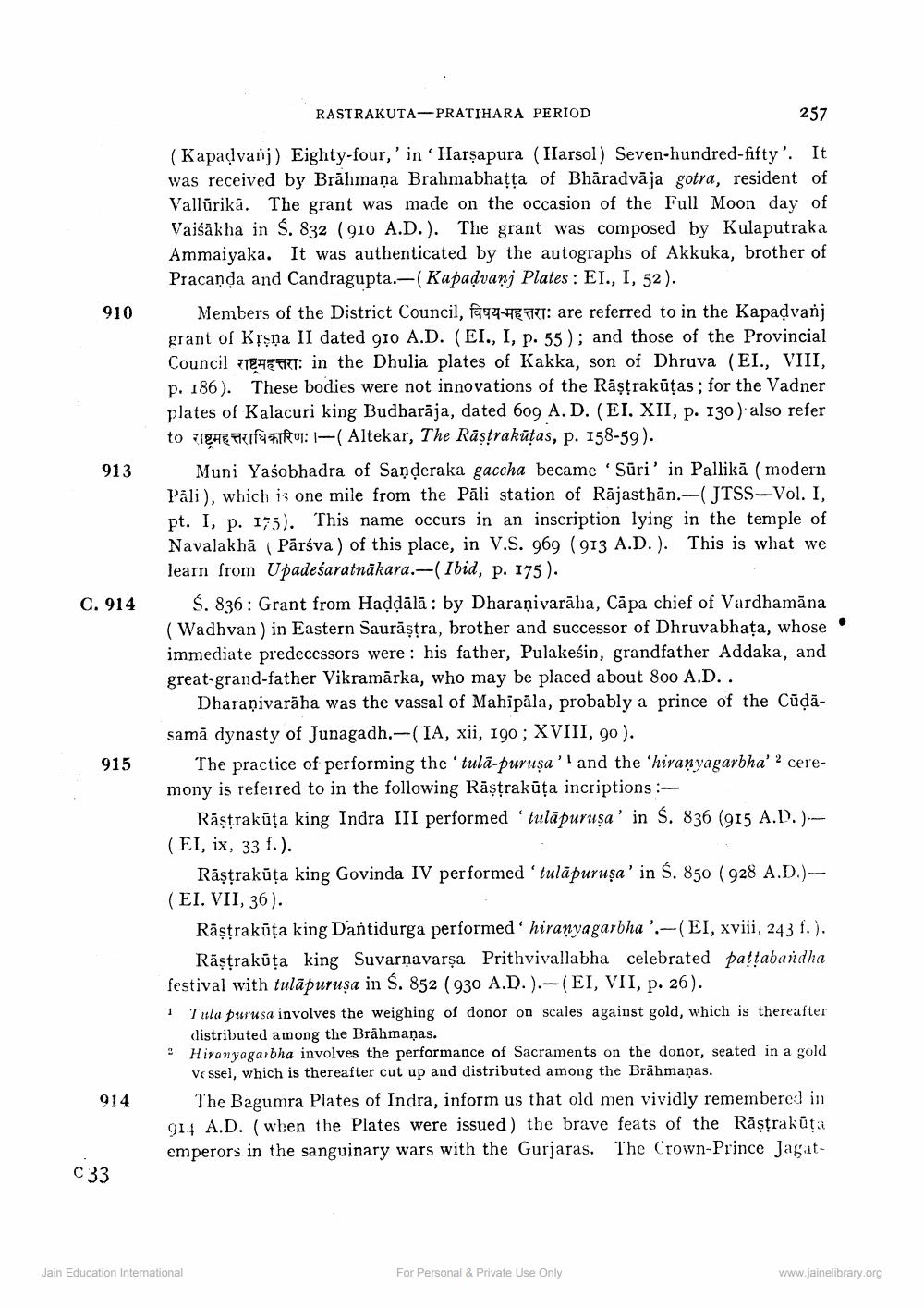________________
910
913
C. 914
RASTRAKUTA-PRATIHARA PERIOD
257 (Kapadvanj) Eighty-four,' in Harsapura (Harsol) Seven-hundred-fifty'. It was received by Brāhmaṇa Brahmabhatta of Bhāradvāja gotra, resident of Vallurikā. The grant was made on the occasion of the Full Moon day of Vaišākha in $. 832 (910 A.D.). The grant was composed by Kulaputraka Ammaiyaka. It was authenticated by the autographs of Akkuka, brother of Pracanda and Candragupta.-(Kapadvanj Plates : EI., I, 52).
Members of the District Council, f4q-heaRT: are referred to in the Kapadvanj grant of Krsna II dated 910 A.D. (EI., I, p. 55); and those of the Provincial Council EHEFIT: in the Dhulia plates of Kakka, son of Dhruva (EI., VIII, p. 186). These bodies were not innovations of the Rāşțrakūtas; for the Vadner plates of Kalacuri king Budharāja, dated 60g A.D. (EI, XII, p. 130 ) also refer to ICAE ERIT TU: - Altekar, The Rāstrakūtas, p. 158-59).
Muni Yaśobhadra of Sanderaka gaccha became 'Sūri’ in Pallikā (modern Páli), which is one mile from the Pāli station of Rājasthān.-(JTSS-Vol. I, pt. I, p. 175). This name occurs in an inscription lying in the temple of Navalakhā Pārsva) of this place, in V.S. 969 (913 A.D.). This is what we learn from Upadeśaratnākara.-(Ibid, p. 175).
Ś. 836: Grant from Haddālā : by Dharaṇivarāha, Căpa chief of Vardhamāna ( Wadhvan) in Eastern Saurāştra, brother and successor of Dhruvabhata, whose immediate predecessors were : his father, Pulakesin, grandfather Addaka, and great-grand-father Vikramārka, who may be placed about 800 A.D..
Dharanivarāha was the vassal of Mahipāla, probably a prince of the Cūdāsamā dynasty of Junagadh.-(IA, xii, 190 ; XVIII, 90 ).
The practice of performing the 'tulā-puruṣa'' and the 'hiranyagarbha'? ceremony is referred to in the following Rāșțrakūța incriptions :
Rāştrakūta king Indra III performed 'tulāpuruşa’ in $. 836 (915 A.D. )-- (EI, ix, 33 f.).
Rāştrakūta king Govinda IV performed 'tulāpuruṣa' in $. 850 (928 A.D.) - (EI. VII, 36).
Rāșțrakūta king Dantidurga performed hiranyagarbha ':-(EI, xviii, 243 f.).
Rāştrakūta king Suvarnavarşa Prithvivallabha celebrated pattabandha festival with tulāpuruşa in $. 852 (930 A.D.).-(EI, VII, p. 26). 1 Tula purusa involves the weighing of donor on scales against gold, which is thereafter
distributed among the Brāhmaṇas. 9 Hiranyagaibha involves the performance of Sacraments on the donor, seated in a gold
Vessel, which is thereafter cut up and distributed among the Brähmanas.
The Bagumra Plates of Indra, inform us that old men vividly remembered in 91.4 A.D. ( when the Plates were issued) the brave feats of the Rāştrakūta emperors in the sanguinary wars with the Gurjaras. The Crown Prince Jagat
915
914
Jain Education International
For Personal & Private Use Only
www.jainelibrary.org




